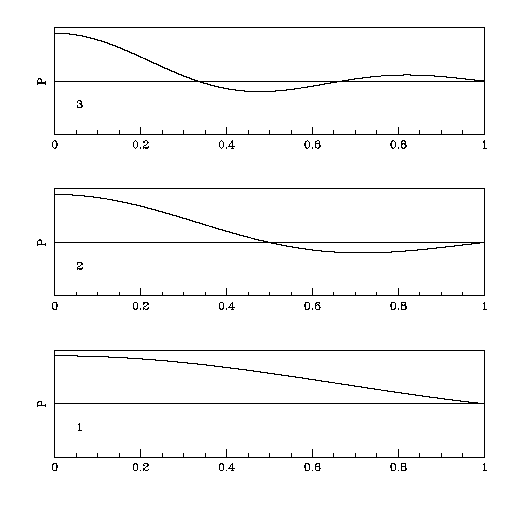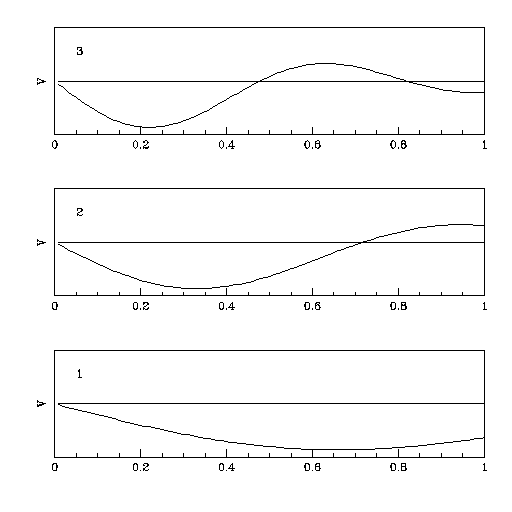 }
}The oboe ( and the saxaphone) differ from the clarinet is one crucial way, namely the shape of the inside bore of the tube. While in the clarinet, this tube is a cylinder (ie the same width along the whole length of the tube), in both the saxaphone and the oboe, the tube is much closer to a cone- ie, the width of the bore decreases steadily from the output end (the bell) to the mouthpiece.
This conical shape to the bore changes the modes of the vibration of the air inside the instrument in a critical manner. The clarinet's modes start with the lowest mode having a frequency given by the expression, (velocity of sound )/ (4 times the length). Thereafter, the modes have frequency which is roughly 3 times the frequecny of the lowest mode (for the second mode) 5 times (for the third mode), 7 times (for the fourth mode), etc. Ie, the clarinet will typically sound only the odd harmonics of the fundamental when it is played. (because of the flare of the bell, and the effects of all of the finger holes, even if closed, on the shape of the bore, the higher modes will begin to deviate from this simply relation to the fundamental, but generally it is good for the first four or five modes).
On the other hand the oboe modes have modes which starts with the lowest having a frequency of (velocity of sound)/(2 times the length) which means that the lowest mode of the oboe has a frequency of twice that of a clarinet of the same lenght. The modes of the oboe, just as that of the clarinet, have a velocity node at the reed end of the intstrument, and a pressure node at the opening. However, because of the smaller and smaller amount of air in the instrument as one gets near the reed, it turns out that the modes act very much as they would in a pipe which is open at both ends. In fact if one plots the product of the distance from the reed times the pressure in the mode, then the plot of this product versus distance from the reed is exactly the same as the plot of the pressure vs distance from the open end of a cylindrical open ended pipe. (The plot of the velocity of the air in any node for the conical pipe does not look anything like the plot of the velocity of the air in an open ended pipe.).
However, while the distance times the pressure goes to zero at the reed end, the pressure fluctuation itself is finite there, and it must be in order to control the opening and closing of the reed. Here are the graphs of the pressure and the velocity of the air in the first three modes of a conical bore pipe.
 }
}
While the reed on an oboe is different from that on a clarinet, by having two pieces of cane vibrating against each other, rather than the one of a clarinet (or a sax) which beats against the body of the reed holder. However the physics is the same. Once the pressure difference between the outside of the reed in the mouth and the inside of the instrument at the reed becomes sufficiently large, that pressure begins to close the reed, so that if the pressure inside the instrument drops further, the reed closes further and the amount of air entering the instrument at the reed decreases. Similarly when the pressure inside gets higher, the reed opens allowing more air to flow in from the mouth. Ie, we again have the same counterintuitive process as in a clarinet. When the inside pressure gets higher, more air flows in and when the inside pressure drops, less air flows in. This behaviour gives the negative resistance needed to amplify the sound in the instrument and compensate for the energy loss experienced by the vibration of the node by the radiation of the sound and the friction of the air motion against the walls of the instrument.
The conical shape of the instrument has two effects. One is the effect on the modes, such that the modes are all of the integer multiples of the lowest mode. The other is that though the reed operates in the same way as on a clarinet, in creating the required negative resistance, the very small amount of air in the instrument near the reed make the instrument much more sensitive to variations in the way air flows in through the reed. This makes the oboe much harder to control and play than is a clarinet. The presence of all of the modes, rather than just the odd numbered modes, means that the oboe also sounds much different from the clarinet. This is especially true since under normal operation, it is usually the case that the strongest mode in the sound of the oboe is the second, rather than the lowerst mode. This helps to give the oboe (and sax) its haunting tone colour.
The fact that the second mode has twice the frequency of the lowest mode also means that if one plays in the upper register, its pitch is an octave, rather than an octave and a fifth as in a clarinet, higher than the lower register. An oboe thus needs fewer keys (openings in the instrument to play different notes) than does a clarinet. A clarinet needs enough openings to play and octave and a fifth (19 semitones) befor you can play in the upper register. An oboe and a sax only need enough for 12 semitones ( one octave) efor you can jump into a higher mode (higher register).
To change register, the oboe, like a clarinet, has a ``register hole", a very small hole bored into the tube. The purpose of this hole is not to "shorten the length" as are the key holes, but rather is a very small hole whose pupose is to damp out the lowest mode sufficiently that the amplification of the reed cannot no longer amplify it sufficiently, and instead the next higher mode gets amplified. On a clarinet this is accomplished by making the register hole at a point roughly a third of the way along the instrument from the mouthpiece. This is roughly the point at which the second mode of the clarinet has a pressure node ( and thus cannot push air thought the little hole to damp out that mode) while the first mode there has a high pressure fluctuation, and thus gets damped by the mode.
In the oboe, one would expect that the register hole would be about half way along the instrument, as that is the place where the second mode has a node, and the first does not. However, the register hole in both the oboe and the saxaphone is very near the mouthpiece (much closer than even in the clarinet). This is still somewhat of a mystery to me. Again the location of the hole must be such as to damp out the first mode more than the second, so that the amplification of the negative resistance of the reed will amplify the second mode rather than the first. Somehow the fact that the oboe has trouble amplifying the first mode, even in the lower register, means that this placement of the register hole works, despite my not understanding why.
The primary difference betweent oboe and the saxaphone, (other than the relatively minor one that the sax uses a single reed like a clarinet, while the oboe uses a double reed) is that the cone angle on a sax is significantly greater than on an oboe. Ie, for the same length of instrument, the opening at the bell is larger for the sax than for the oboe. This drops the knee frequency of the sax, and means that the sax tends to be a much louder instrument than does the oboe. Making the instrument out of metal rather than wood, can also have an effect on the damping of the higher frequencies inside the instrument (the pressure fluctuations on the wood inside the instrument, which are very similar for both at about 130-140 dB, will damp out against the wood- wood is more absorptive than brass- more readily)